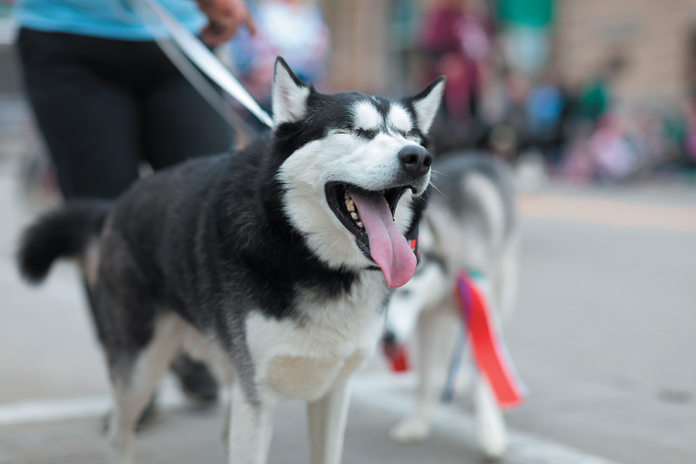Last month we discussed walking a dog who is uninterested in or a little wary of people outside of his social group, but who won’t fall apart if he is approached. But what if your dog is truly afraid?
Perhaps he quakes, literally, with his tail between his legs. Maybe he urinates submissively, too. Alternatively, he might lunge aggressively.
These opposite reactions are actually two sides of the same coin. A scared dog will cower and perhaps freeze in position with eyes blinking and darting. Or he may go on the offensive in an effort to protect himself if he feels your own efforts to protect him won’t be effective. And if he does tend to become aggressive when afraid, being tethered to a leash could compound the problem. He can’t move away, so he’ll figure that aggression is the only response to the situation that will keep him safe.
Aggressive or exhibiting cowardice, the dog is suffering. What should you do?
Setting boundaries
“You need to be an advocate for your dog and be willing to create boundaries around him to keep him safe from unwanted interactions,” says the head of the Tufts Animal Behavior Clinic, Stephanie Borns-Weil, DVM. There are a number of ways to do that.
- Walk your dog in environments that will limit the number of people who will want to come up to him and perhaps pet him. “If you bring him to a crowded farmer’s market or a charity dog walk event where there are a ton of dog-friendly people moving about with their pets, you’re setting your dog up for failure,” Dr. Borns-Weil says. Keep him away from such places and opt for areas that won’t be apt to have a lot of people. And choose situations that don’t come with an expectation that dog petting is part of the outdoor experience.
- Become a body blocker. With the tools of treats and praise, you can teach your dog to step behind or to the side of you on cue. That way, when someone approaches, even if they don’t intend to pet your canine pal, you can attenuate your dog’s fear by blocking his view of the “intruder.” You can also teach your dog to move to the opposite side of you in order to increase distance between him and the person coming toward him. Encouraging him to create distance can prove very useful — and comforting for your pet. If you have a dog who lunges at people who walk near him, such moves become all the more valuable.
- Put a vest on your dog that has wording asking people to keep away from him. Some leashes come with such wording, too, although it’s easier to see on a vest. A website that lists outfits selling gear with the right words is DogsInNeedOfSpace.com, or DINOS. For instance, you can purchase a “Please Give Me Space” vest or a bandana with phrases like “I’m shy” and “Please don’t approach.” You can design your own vest, too, with the wording of your choice.
People report anecdotally that wording that says things like “Do not approach” elicit better compliance than gear that says “Fearful.” “Do not approach” and “Do not pet” are unambiguous. “Fearful” doesn’t necessarily make it clear to passers-by about your expectation that they should not come near your dog.
Dr. Borns-Weil points out that the DINOS website is good not just because it can help you find gear with the right wording. It is also a great resource in general for helping people whose dogs need space. It lists support groups, low-cost online classes, and books and articles to assist those whose dogs require wide berth for their sense of security.
How to approach a scared dog
As a dog lover, you can also help fearful dogs who are being walked by someone else.
For starters, if you sense or see that the dog is anxious, do not assume that you are the person who’s going to be able to make the breakthrough for this animal. Instead, disengage. “Avert your eyes,” Dr. Borns-Weil says. A direct gaze can be interpreted by a dog as a kind of “Put up your dukes.”
Don’t talk to the dog, either. Just increase distance as much as possible and keep walking. You are not being unfriendly. You are being respectful, and the dog will very much appreciate it, as will his owner.
Along the same lines, don’t try to have a conversation with the dog walker. Even though you’re not engaging with the dog, he will still feel afraid. He needs you gone. That said, if you can quietly tell the person they are doing right by their dog as you pass (as long as it won’t upset the dog), the positive feedback will help them continue to protect their pet.
“It can be pretty lonely out there for people with a reactive dog,” Dr. Borns-Weil says. “A lot of folks shame people for having a reactive pet, which makes it that much harder. Even a thumbs-up as you pass can be really welcome.”
This is the second in a three-part series about dogs who are uncomfortable socializing with strangers. In the April issue, we will discuss how to help dogs achieve success with people from the get-go, when they are puppies.





